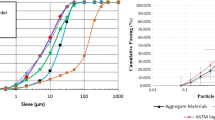Abstract
Malaysia is among the countries that have abundant reserves of raw material to be used to form metakaolin (MK). Only a few studies are available in the literature, which examines the potential of the development of metakaolin through calcination and its use as supplementary cementitious material (SCM). The use of MK as SCM is essential to utilise the local resources and to reduce the carbon footprint and embodied energy in the use of cement. Thus, MK developed at laboratory scale, produced through using local source, is compared with the commercially available micro-silica by investigating their properties in this paper. The concrete made of MK and micro-silica was tested under compression, split tension and bending. The comparison of the phase difference between MK and micro-silica had carried out through X-ray diffraction pattern. Besides, an interfacial transition zone of concrete made of MK and micro-silica had observed through field emission scanning electron microscopy. A total of three mixes of concrete had prepared, out of which one was without cement replacement and served as control mix. The remaining two mixes were 10% cement replacement with micro-silica and MK. The results showed that MK has high reactivity with portlandite in concrete due to its irregular structure and the amorphous phase. The compressive strength was 4% higher with MK as compared to micro-silica at an early age. MK concrete displayed a higher split tensile strength of approximately 14% and 35% and a higher load-carrying capacity of approximately 15% compared to micro-silica and competitive with control concrete at ages 7–90 days.












Similar content being viewed by others
References
Abdullahi T, Harun Z, Othman MHD, Yusof KN, Rahmawati A, Yunos MZ, Lajis MA, Yusof Y (2019) Preliminary studies on hydrothermal synthesis of zeolite from Malaysian kaolinite clays. Malays J Fundam Appl Sci 15(3):421–425
ACI 363R-92 (1992) State-of-the-art report on high-strength concrete. ACI, Farmington Hills
Ashish DK, Verma SK (2019) Cementing efficiency of flash and rotary-calcined metakaolin in concrete. J Mater Civ Eng 31(12):04019307
Baioumy H, Ibrahim AR (2012) Mineralogical variations among the kaolin deposits in Malaysia. In: Annual international conference on geological and earth science
Bakera AT, Alexander MG (2019) Use of metakaolin as supplementary cementitious material in concrete, with focus on durability properties. RILEM Tech Lett 4:89–102
Ding J-T, Li Z (2002) Effects of metakaolin and silica fume on properties of concrete. ACI Mater J 99(4):393
Duan P, Shui Z, Chen W, Shen C (2013) Effects of metakaolin, silica fume and slag on pore structure, interfacial transition zone and compressive strength of concrete. Constr Build Mater 44:1
Ismail MK, Hassan AA (2016) Use of metakaolin on enhancing the mechanical properties of self-consolidating concrete containing high percentages of crumb rubber. J Clean Prod 125:282–295
Justice JM, Kennison LH, Mohr BJ, Beckwith SL, McCormick LE, Wiggins B, Zhang ZZ, Kurtis KE (2005) Comparison of two metakaolins and a silica fume used as supplementary cementitious materials. SP-228, ACI, Farmington Hills, Mich, pp 213–236
Kakali G, Perraki T, Tsivilis S, Badogiannis E (2001) Thermal treatment of kaolin: the effect of mineralogy on the pozzolanic activity. Appl Clay Sci 20(1):73
Khan SU, Nuruddin MF, Ayub T, Shafiq N (2014) Effect of different mineral admixtures on the properties of fresh concrete. Sci World J 2014:1
Martin SJ (1995) The use of metakaolin in high strength concrete. RMC Readymix Limited, Tech Rep, Laboratory Report, 78
Muduli R, Mukharjee BB (2020) Performance assessment of concrete incorporating recycled coarse aggregates and metakaolin: a systematic approach. Constr Build Mater 233:117223
Newman JB (2003) Advanced concrete technology: constituent materials. Butterworth-Heinemann, Oxford
Poon CS, Kou SC, Lam L (2006) Compressive strength, chloride diffusivity and pore structure of high performance metakaolin and silica fume concrete. Constr Build Mater 20(10):858
Shafiq N, Nuruddin MF, Khan SU, Ayub T (2015) Calcined kaolin as cement replacing material and its use in high strength concrete. Constr Build Mater 81:313–323
Shvarzman A, Kovler K, Grader GS, Shter GE (2003) The effect of dehydroxylation/amorphisation degree on pozzolanic activity of kaolinite. Cem Concr Res 33(3):405
Siddique R, Klaus J (2009) Influence of metakaolin on the properties of mortar and concrete: a review. Appl Clay Sci 43(3–4):392
Speakman SA (2011) Basics of X-ray powder diffraction. The Center for Materials Science and Engineering at MIT, Tech Rep, Massachusetts, USA
Author information
Authors and Affiliations
Corresponding author
Rights and permissions
About this article
Cite this article
Khan, S.U., Ayub, T. & Shafiq, N. Physical and Mechanical Properties of Concrete with Locally Produced Metakaolin and Micro-silica as Supplementary Cementitious Material. Iran J Sci Technol Trans Civ Eng 44, 1199–1207 (2020). https://doi.org/10.1007/s40996-020-00436-3
Received:
Accepted:
Published:
Issue Date:
DOI: https://doi.org/10.1007/s40996-020-00436-3




